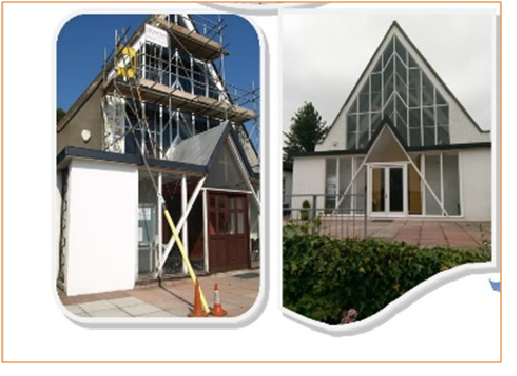Work at the Mother House
On 24th July, Sr. Pauline, the General Council and Sr. Marie Ducrot (representing the Delegation of France) met with the development company, ADIM and our solicitors to discuss the current situation regarding the refurbishment of the Mother House.
ADIM informed the group that the new owners of the apartments being built in the Mother House will move in on 6th September although some exterior work around the building will continue during September.
It is hoped that the Mayor will formally inaugurate the new building at the end of October. ADIM have gifted the Congregation a piece of stone artwork that will be erected in the garden outside the Scare Coeur community and the Generalate. It will be of opened hands and words etched into the base will reflect our charism of receiving, living and sharing the great love of God. There will be a ceremony to inaugurate this statue at the end of September before the outgoing Council leave France.
It was also agreed that there will be an opportunity for Sisters to view the refurbished building – at a date to be arranged - before the residents move in.
After the meeting there was a tour of the Mother House in order to see how far the work has progressed followed by lunch with those working on the Mother House apartments.
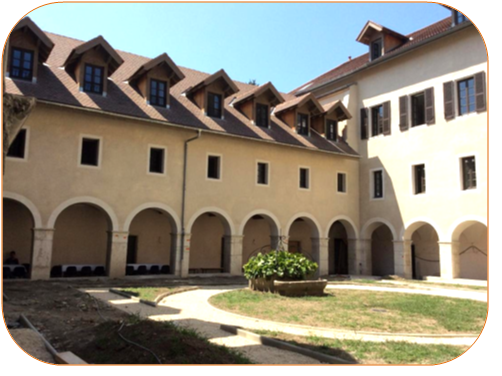
Work on the refurbished Cloister area – note the brand new Jacobean windows
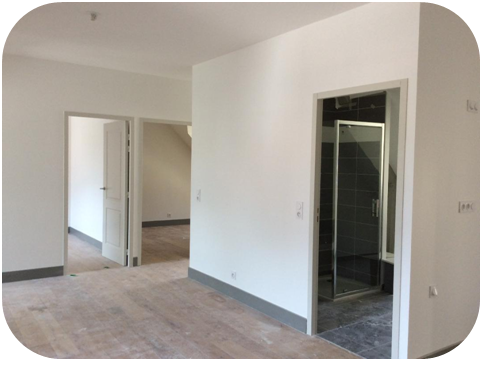
An apartment nearing completion
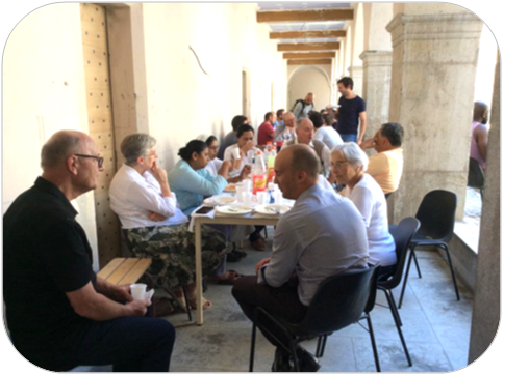
Lunch with the workers.
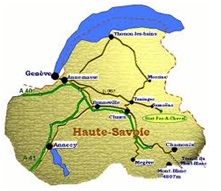
Diocesan Migrant Pastoral Day
On Sunday, February 24, 2019, wetook part in a meeting organized by the Migrant Welfare group of the Diocese of Annecy. About a hundred people of different nationalities, languages and religions came. They originated from countries in Africa, Asia and Europe, including Lebanon, Macedonia, Kosovo, Afghanistan, Pakistan and India. Among them were many asylum seekers. Christians and Muslims realised they felt part of the same family.
The day began with the "hello chain" in different languages. This created a joyful and friendly atmosphere. Three people gave their testimony:
A mother of four: from Kosovo testified to the welcome and friendship she enjoyed upon her arrival in the village.
Thanks to this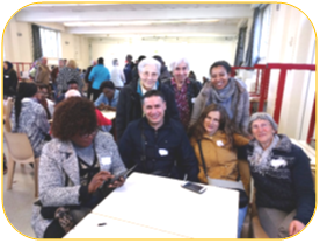 friendship, she was able to overcome the enormous difficulties she faced. She has now obtained her papers and she demonstrated to us all, with great emotion, how grateful she was.
friendship, she was able to overcome the enormous difficulties she faced. She has now obtained her papers and she demonstrated to us all, with great emotion, how grateful she was.
Two Frenchwomen from a small parish explained how the word of the Gospel "Ephata", heard at Mass, led to the creation of a small team of 15 people. They have been looking out for ways to reach out to others and are committed to welcoming and accompanying a family of asylum seekers to their parish. What came over most clearly was all they were gaining from these encounters.
The team had come into contact with young people from a high school to whom they spoke about the migrant situation. They, in turn, wanted to become involved and invited a young migrant to go skiing with them. At Christmas many invited friends and family to celebrate with the migrants and to share what they had been discovering.
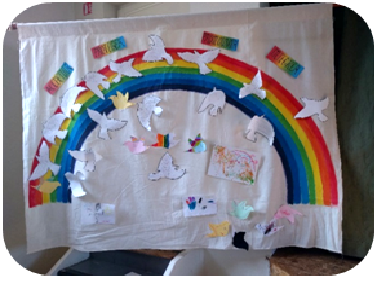
The morning continued with discussions where we shared our experiences of joy despite our frailties. The exchange was very rich and full of simplicity and confidence, thanks to the attentive listening to one another. The children formed their own groups, accompanied by one or two adults.
At the end of the morning, each group read a few phrases remembered from their conversations and wrote them on a dove. These were placed on a huge rainbow, a symbol of our diversity.(see above)
At lunchtime, everyone enjoyed the various dishes prepared by different families and it was a beautifully animated time for dance and celebration.
The day ended with two options: the Eucharist for Catholics and a time of sharing for Muslims. We were surprised to find that some Muslim Kosovars stayed with us for the Eucharist, brothers and sisters of the same Father …together.
Sr Anna and Sr Marie
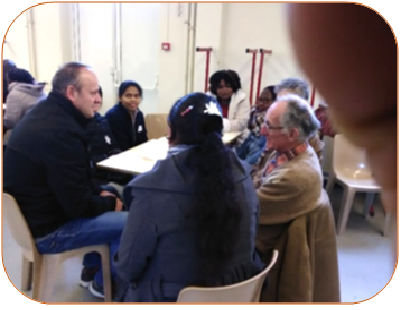
The Catholic Church in the Rhondda
Growth and Decline 1886-2019.
The undulating green hills overlooking the Rhondda Valleys tend to hide a history of coal mining, hard work, suffering but also prosperity in the Rhonda Valley towns. A section of the local cemetery, where the grave stones bear the inscription of so many Irish and Italian names, reminds the visitor of the generations who gave birth to the Church in this region.
The story of one family, told by Sadie, now 93 years old, illustrates a typical history of how the Irish came to Tonypandy back in the 1880’s. Her grandfather died young leaving her grandmother to work a farm and care for her four children. She was unable to make enough money to pay the rent on this farm so she was evicted from her home. She took her youngest child James, Sadie’s father, with her and moved in with her brother to work on his farm. The other children were cared for elsewhere.
James grew up and at the age of 24 decided to go to Wales to find work. On the boat he met a man who said there was plenty of work in Tonypandy in the mines so the two travelled on together. At that time it was usual for families to take in lodgers to boost their income so James lodged with a family and went to work in the local coal mines. At that time there was no Catholic Church but a priest came from Cardiff to say Mass in a public house about four miles from Tonypandy.
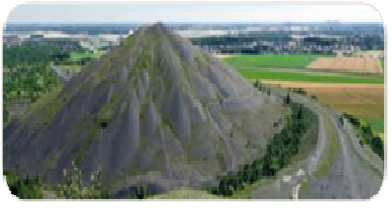
Terril: Mine cuttings
Eventually, Cardiff Diocese bought a plot of land in Tonypandy and the Irish men, after a hard day’s work in the mines, set about fetching stones from the quarry and building the Church. It was opened in 1886 thanks to the hard work of the volunteers who were mostly Irish.
James married a Welsh girl who became a Catholic and they had four children, Sadie being one of them. She remembers her mother cleaning and scrubbing the Church floor on her knees. The Church was then heated by an open coal fire. Sadie, like her mother, continued to clean the Church in her day and at present Sadie’s daughter, now about 65, with two other ladies continue the good work.
The Church is now carpeted, re-decorated and centrally heated. There will not be a next generation of this family to take over as the young people, like so many others, have left the valleys to find work.
The first priest in Tonypandy was a Fr. Bray and he was succeeded in 1894 by Fr. Griffiths. People were poor and were not able to support a priest. Fr. Griffiths died of malnutrition despite the fact that local people, mostly non-Catholics, often gave him a bowl of soup knowing that he, in turn, frequently gave what he had to poor families. However, as the years went by and the Congregation grew, both the town and Church profited from the miner’s incomes.
In the 1920’s two other churches were built in the Rhondda valleys, Treorchy and Ferndale but when, in the 1960’s the mines closed, congregations grew smaller and these two churches were also closed, much to the regret of the local people.
Tonypandy survived partly because it was attached to the one Catholic Primary School. By 2016 there was no resident priest to say Mass so the Bishop asked for two Sisters to help out. Now a visiting retired priest comes at week-ends to say Mass and two Sisters, Berenice and Joanna have moved into the Presbytery to care for the spiritual needs of the people -particularly the sick and housebound. It is very rewarding work to be able to bring Holy Communion and some comfort to people whose ancestors kept the faith alive in this area for one hundred and fifty years,
About one hundred people attend Mass every week-end. Many are from the Philippines who work in local hospitals and have young families. The Welsh/Irish/Italian parishioners are generally retired people.
The Italians also made a great contribution towards the Church in the Rhondda Valleys - but theirs is another story which is very well worth recording.
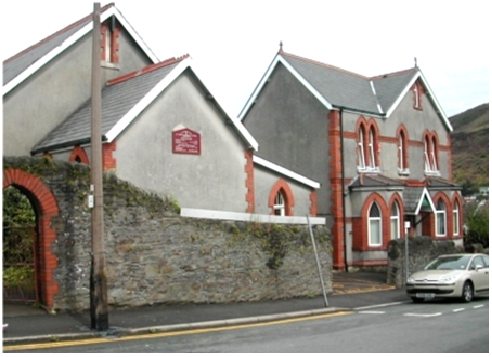
Rêves et Réalités Vie en Paroisse-Angleterre
A mon retour à la Province d’Angleterre, après mon mandat de Secrétaire Générale, je rêvais d’avoir davantage de temps pour prier et pour écrire – du temps pour ETRE. C’était un beau rêve mais pas la réalité car je me suis rapidement trouvée immergée dans la vie d’une paroisse et de ses multiples problèmes.
Il y aura bientôt 5 ans, j’ai été envoyée avec Sr Maureen Davis à la paroisse du Saint Sacrement, Rumney, Cardiff, paroisse sans prêtre après le décès du curé en charge. Sr Maureen a poursuivi son travail en temps que Responsable du Centre Pastoral Diocésain. Quant à moi j’ai été chargée de cette Paroisse. Nous suivions les offices de la paroisse voisine, St Jean Lloyd, distante à un peu plus de 2 kms.
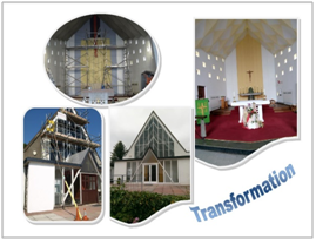
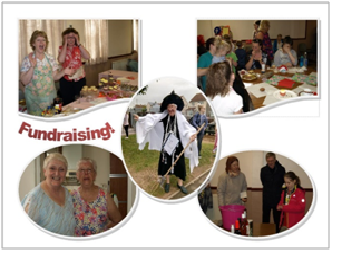
Le presbytère du Saint Sacrement, avait été remis à neuf avant notre arrivée mais rien ou très peu avait été fait au niveau de l’église, ces 30 dernières années. Elle avait un besoin urgent de réparations causées en particulier par des gouttières. Chaises, bancs etc. linge d’autel étaient en très mauvais état à cause de l’humidité. La première chose fut de mettre en place un Groupe d’Action Paroissiale pour partager les nombreuses tâches à entreprendre : planning, nettoyage, collecte de fonds etc. en d’autres mots assumer les responsabilités.
De toute l’Europe, la paroisse accueille le nombre le plus important de voyageurs. Elle peut offrir le gite à environ 2 000 personnes qui considèrent « The Blessed Sacrement » comme leur paroisse. Parmi eux, les Irlandais, grands voyageurs, qui gardent l’ensemble de leurs traditions. La plupart vivent en Irlande mais aussi dans d’importantes communautés au Royaume Uni et aux Etats Unis. Sur la paroisse, se trouve également une assez grande communauté d’Indiens, la plupart du Kérala ; mais aussi des Philippins, des Africains, des Polonais et des Italiens, tous très bien intégrés. Les paroissiens sont très généreux et travaillent avec « Le Groupe d’Action » pour l’animation Avec eux, nous avons mis sur pied divers moyens pour lever des fonds (très nécessaires) pour développer et animer la vie de la Communauté, partager joies et épreuves. Une première action pour obtenir de l’argent : une marche d’environ 2 kms pour tous, y compris les personnes avec leur déambulateur ou leur canne, etc. Moi-même, j’ai parcouru le trajet, déguisé en « bonne » sorcière, à califourchon sur un manche à balai.
L’église maintenant n’a plus de gouttières ; repeinte à l’extérieur et à l’intérieur, elle présente un aspect accueillant et soigné. Grâce à la générosité de la Province, le linge d’église, les nappes ont été remplacés. L’église est maintenant un lieu digne pour l'adoration. Toujours grâce à nos sœurs, nous avons maintenant toute une collection de statues de jardin spéciales pour Pâque. Nous sommes loin de la première fête de Pâque, lorsque nous collions des symboles de la fête, sur du plâtre en décomposition, pour illustrer la joie de Pâque.
Parfois, quand je me reporte à ces débuts, je me sens être, tour à tour, un responsable des travaux, un expert en échafaudage, un bûcheron, un peintre, un décorateur. En réalité, j’étais bien davantage que tout cela. Le bâtiment-église est seulement un chemin pour une réalité plus haute : partage de l’Amour de Dieu avec toute personne rencontrée, un lieu pour approfondir la vie de prière.
Deux évènements particuliers rythment l’année : les chants de l’avent aux chandelles et, chaque premier vendredi du mois, l’Eucharistie suivie de l’Exposition du Saint Sacrement. Ce temps de prière se termine par un léger repas. Au début, les chants de l’Avent rassemblaient peu de monde, actuellement une centaine de personnes dont le chœur de l’école primaire de la paroisse St Jean Lloyd ; ce qui crée des liens solides entre la paroisse, l’école et les familles.
L’été dernier, nous avons eu la joie d’assister à l’ordination d’un paroissien. Pour la cérémonie, la cathédrale était pleine de monde et également le jour suivant pour la première Messe. Occasion unique pour vivre ce qu’il y a de meilleur en nous et souvenir que nous sommes déterminés à conserver longtemps.
Une catéchèse sur les sacrements réunit notre paroisse à celle de St Jean Lloyd ; ce qui a permis aux laïcs d’avoir assez de confiance en eux-mêmes pour partager leur foi. Les catéchistes des deux paroisses commencent à prendre des responsabilités. Notre groupe de base est devenu un soutien pour le programme du RCIA, Initiation des adultes aux rites chrétiens. Dernièrement, il s’est transformé en un groupe d’échange de la foi et d’évangélisation. Nous avons formé plusieurs paroissiens pour porter l’Eucharistie aux malades et aux personnes confinées dans leur maison. Maintenant ils ont pris en charge ce ministère. La semence a été jetée et nous espérons que l’Esprit saint féconde chaque petite graine et fasse grandir la foi.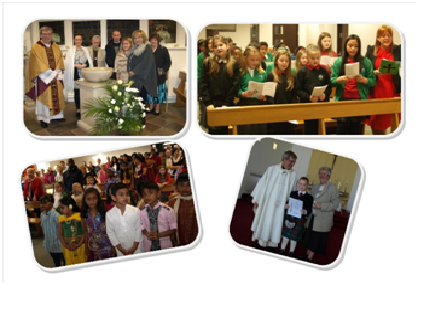
Moi-même, ces deux ou trois dernières années, j’ai suivi la formation pour la conduite des funérailles, réalité toute nouvelle dans le diocèse. Ministère privilégié pendant les deuils où les personnes rencontrées sont très vulnérables et réceptives. C’est pour moi une tristesse de constater que, malgré la foi pratiquante de la personne décédée, la génération suivante ne pratique plus et a peu de connaissance sur la notion chrétienne de la mort. C’est un véritable défi de les rejoindre avec notre foi, car pour beaucoup d’entre eux, c’est une des rares occasions d’un contact avec la religion.
La présence d’une importante communauté itinérante demande aussi beaucoup d’investissement. Leur compréhension de la foi et leur pratique différent beaucoup de la nôtre. Nous ayons réussi à initier les jeunes aux programmes de la Confirmation et de la première communion. Les parents eux-aussi suivent la préparation au baptême. Comme beaucoup sont analphabètes, nous n’utilisons pas de textes écrits, mais des DVD qui permettent des échanges. Nous vivons parfois des situations homériques à l’occasion de mariages ou des funérailles. Il arrive que des groupes rivaux se battent. Nous avons vécu une sépulture mémorable lors d’une rixe, qui a fait la UNE des journaux nationaux : la police a dû intervenir et l’hélicoptère survoler le cimetière pour maintenir l’ordre.
D’une façon ou d’une autre, j’ai été impliquée dans l’éducation pendant de nombreuses années. J’ai toujours aimé le contact avec les enfants et les éducateurs quand j’étais directrice de l’école St Jean. J’ai contribué à promouvoir l’esprit de l’école catholique. Ce me fut une grande joie quand, récemment, l’école St Jean a été inspectée et félicitée.
Mon rôle est aussi de renforcer les liens entre l’église et l’école, de soutenir l’équipe enseignante ;c e qui m’a permis de mieux connaître les familles.
Que reste-t-il de mon rêve ? Il s’est transformé avec la réalité de la vie. J’ai eu le privilège de travailler avec et pour beaucoup de personnes merveilleuses. Elles m’ont partagé leur vie et j’ai partagé avec elles les richesses de notre charisme, dans les moments heureux et plus difficiles. J’ai essayé de donner mais j’ai reçu, en retour, bien davantage. J’aime ce que je fais. C’est parfois difficile et exigeant mais n’est-ce pas ce que sont les rêves, eux aussi ?
« Nous allons de préférence vers les pauvres et les plus délaissés. Nous cherchons à susciter des apôtres capables de répandre le message de l’évangile : que tous sont appelés au plus grand Amour. »
Ce serait merveilleux d’entendre le témoignage d’autres Sœurs de St Joseph.
Sœur Marie de Montford
